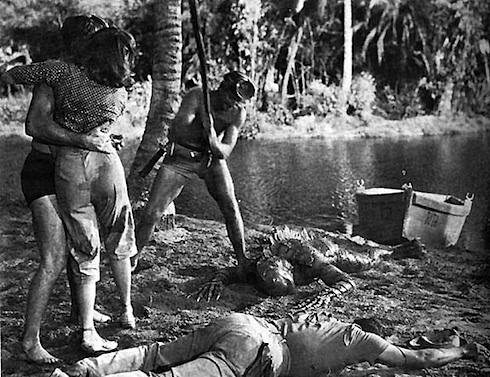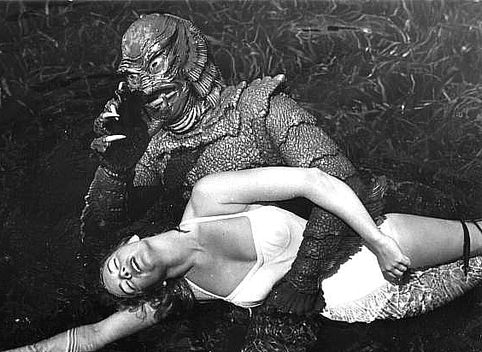Just because your protagonists in genre fiction aren’t human people, doesn’t mean we can’t feel for them. We recognize our panicky emotions in a robot like C-3PO or our warm, familiar tendencies in the talking fish one Finding Nemo. Hell, one of the most famous novellas of all time focuses on a man/cockroach named Gregor Samsa, and we’ve all had Monday mornings that feel a little like that. But when you’re narrator is and always has been a monster; specifically a “Creature from the Black Lagoon” it’s trickier to get your reader /audience to root for the monster. And yet, in both the original film — The Creature from the Black Lagoon and Jim Shepard’s literary short story adaptation “The Creature from the Black Lagoon” — we’re on the Creature’s side the whole time. Here’s why.
At the time of its release The Creature from the Black Lagoon broke several records for the amount of actual underwater photography in a feature film. This achievement apparently wasn’t enough for cinematographer Bruce Mozet and director Jack Arnold, since they also decided to shoot the entire thing not only underwater, but in 3-D, too. In 1954 these guys must have been considered totally nuts. If you think the 3-D craze is seeing a comeback now, The Creature from the Black Lagoon was partly an attempt to revitalize it then.
But 3-D or no 3-D, the movie strikes a chord partly because of the design of the creature is both scary, but also a little sympathetic. Doesn’t he look a little sad when he’s knocking those guys off the boat with his killer claws? In Jim Shepard’s short story, the Gill-Man is given a backstory of slowly becoming a loner over the course of centuries. His kind had become “a joke by the Triassic and fish food by the Cretaceous.” Even in prehistoric times the Gill-man was kind of a loser. As time passes at the beginning of the story, the Gill-Man suddenly realizes his species is almost totally extinct.
How long had it been since I’d seen one of my own? We hadn’t done well where we’d been, and our attempt at a diaspora had been a washout.
I’d gotten pitying looks from the plesiosaurs.
Was I so unique? In the rain forest, the common was rare and the rare was common.
In the film and the story, the solitary nature of the Creature is made worse by the relentless attempts of capture by the humans. As I pointed out in my re-watch of the film last October, the character Mark is a big time asshole with no regard for the scarcity of the Creature’s species or his emotional plight. But this is a trick of monster fiction. In real life most of us would probably be on Mark’s side. Let’s take this thing out or lock it up! I mean, it’s killing us one by one! But, here the humans keep the ropes dangling by the side of the boat, totally inviting the Gill-man to roll up and screw with everyone. As Shepard has the Creature say to himself in the story:
I hauled myself back up the rope — why didn’t they just pull up the rope? — and schulumped past the porthole while they argued. I was dripping all over the planking. I grabbed the crewmember by both sides of his head and toppled us over the rail.
By making the humans so absurd and one-dimensional, the only depth (pun intended) we can ascribe to a character, is the Gill-man. There’s a reason why you’re depressed at the end of this movie, you never wanted them to kill that poor sea monster, in fact you kind of wanted to see him take every single person on that boat out. Is a revenge fantasy designed to fight basic ennui okay? Is the rampage of the Creature like a comforting fever dream for anyone who has been sad and lonely? The Creature is a pathetic figure to be sure, but his ferocity and ability to handle himself are oddly the things making him sympathetic. It’s also what creates the emotional investment in the movie and the story. Let’s see what else this guy can do, we think to ourselves.

Fantasies often are disappointing, and even monsters can set-up unrealistic goals for themselves. In the short story, Shepard has the creature musing over his own expectations of himself with a revealing and bittersweet inner monologue:
I decided to spend more time on the bottom of the lagoon. I was alternately appalled and bemused by my need to spy. I got the sulks. I kept my distance.
Over the years I’d been continuously taken aback by the ingenuity with which I could disappoint myself.
The Creature’s lonely ennui leads him to being anti-social, which he hates. And yet he still wants to pop his head out of the water and check out how all the people are doing. The Lagoon then is his security blanket, his way of dealing with the depressing truth of his life: that he is the last of his kind. That he has a desire to maim and kill. That he will never be loved. Is all of this subtext in the film? You bet. I don’t think Jim Shepard could have pulled out the pathos of the Gill-man without the obvious dramatic texture in the source material.
The Gill-man stands alone among sea monsters insofar as he is not really based on any one myth, legend or story. Instead, he seems to rise up from some kind of basic dark place many people feel. And when he does come out of the water to inflict terror, we’re rooting for him (and ourselves) the whole time.
Ryan Britt is the staff writer for Tor.com. He was written about The Creature from the Black Lagoon and Jim Shepard many times before. As Isaac Asimov once said “…an essay is an attempt.” Someday these thoughts will be perfect.










